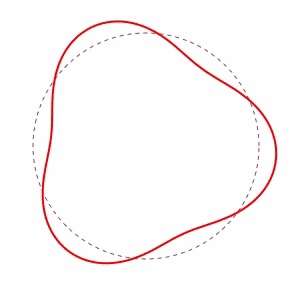December 10, 2012 feature
Magnetic bubbles behave differently than other magnetic defects (w/ video)

(Phys.org)—Magnetism may be one of the most fundamental concepts in physics, but under the surface, magnetism holds complex secrets that scientists are still trying to unravel. One of these areas involves the dynamics of magnetic topological defects in thin films of ferromagnetic materials. In a new study, physicists have demonstrated that magnetic topological defects called skyrmions, which resemble swirling eddies or bubbles, behave differently than do other magnetic defects. The scientists show that skyrmions' unusual behavior arises from the strange occurrence of waves on the bubbles' edges that travel with different speeds in opposite directions.
The physicists, Imam Makhfudz and Oleg Tchernyshyov at the Johns Hopkins University in Baltimore, Maryland, US, and Benjamin Krüger at the University of Hamburg in Germany, have reported their discovery of some intriguing dynamics of skyrmion bubbles in a study recently published in Physical Review Letters.
Scientists have previously known that skyrmions aren't like other magnetic defects that exist in thin-film ferromagnets. The dynamics of a more typical defect, a vortex, has been described as resembling the motion of charged massless particles in a magnetic field. Scientists originally expected skyrmions to move in a similar way. However, recent simulations have shown that the behavior of skyrmion magnetic bubbles significantly deviates from this model. Whereas vortices displaced from an equilibrium position follow a circular trajectory, the trajectory of the center of a skyrmion bubble follows roughly a more complicated curve, namely a hypocycloid.
To explain this puzzling trajectory, the physicists here have shown that skyrmion bubbles must possess inertial mass. The mass is generated not at the center of a bubble but rather at its edge. According to the physicists' equations, waves on the boundary of a bubble travel left and right at different speeds. While the slow waves are insensitive to inertia, the fast waves involve magnetic oscillations, giving the bubbles mass.
"The greatest significance of our work, in my view, is the existence of these funny waves that travel back and forth with different speeds," Tchernyshyov told Phys.org. "This is very unusual, as normally waves travel with equal speeds in opposite directions. There are a few examples of physical systems where that happens, e.g., the edge of a Quantum Hall liquid, where electrons move in one direction only. Such systems know right from left, so they are called 'chiral.' Ours is another example of waves in chiral systems."
When skyrmion bubbles are modeled as objects with mass that contain propagating waves on their edges, the equations accurately describe the observed motion. This understanding of the dynamics of these odd magnetic entities is not only interesting from a basic physics perspective, but also for potential applications.
"Magnetic bubbles and other topological defects can be used as memory or logic elements," Tchernyshyov said. "Stuart Parkin at IBM has made some waves with his concept of racetrack memory, in which he uses domain walls in magnetic nanowires for computational purposes. Whether skyrmions will be eventually used in technological applications is anyone's guess. Our work is directed more at understanding the basic physics of magnets."
Tchernyshyov added that this investigation of the dynamics of skyrmion bubbles is just one part of the researchers' broader goals of better understanding magnetic defects in general.
"This work was part of a larger scheme," he said. "The motion of topological defects in magnets is a complex phenomenon. A few years ago we came up with a new approach to its theoretical description. We proposed a simple and economical theory to describe the most important aspects of their motion [Phys. Rev. Lett. 100, 127204 (2008)]. The current paper is one of the applications of this new language. We are currently working on classifying magnetic textures by topology in three-dimensional magnets, as opposed to two-dimensional thin films."
More information: Imam Makhfudz, et al. "Inertia and chiral edge modes of a skyrmion magnetic bubble." Physical Review Letters, 109, 217201 (2012). DOI: 10.1103/PhysRevLett.109.217201 . Also available at arXiv:1208.3123 [cond-mat.mes-hall] arxiv.org/abs/1208.3123
Journal information: Physical Review Letters
Copyright 2012 Phys.org
All rights reserved. This material may not be published, broadcast, rewritten or redistributed in whole or part without the express written permission of Phys.org.





















